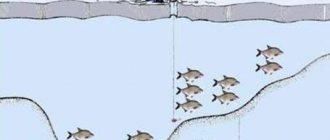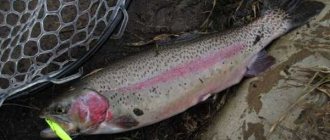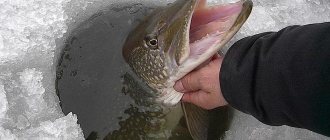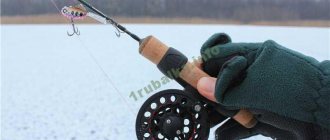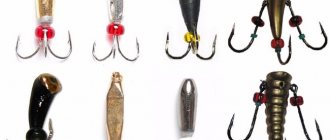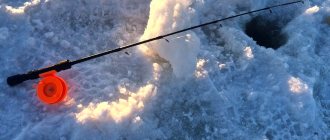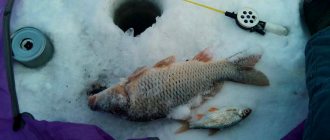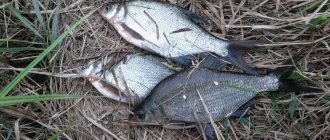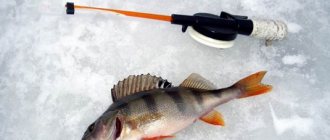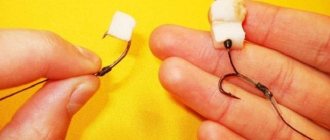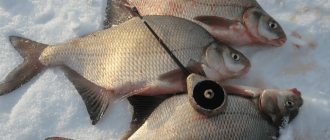Features of fishing for devil
The main feature of this kind of fishing is that you have to start a game with the fish. Your task is to make the fish interested in a new outlandish thing that constantly twitches and attracts attention. The devil is needed when a regular hook with a nozzle is ignored. This kind of fishing will be active. Your task is not only to find a school of bream, but also to make them bite.
Now let's figure out what a devil is:
- The shape resembles an elongated oval, which has 3 hooks on the sides.
- It has the same proportions in shape and weight.
- The hooks are also located symmetrically.
- This design arouses the interest of fish.
- Some experts claim that the devil looks like a crustacean.
- In the dead of winter, even a pike can fall for such bait.
The best devil has the following qualities. A small tee and a black jig weighing no more than three grams. For a better catch, you should decorate with beads. Now let's talk about weight. If the water is calm, one gram is enough. The bream will carefully examine this tackle and then bite. Even with a light touch, the fish will still sit on the hook. The main thing is not to miss the moment and make the cut in time. If the body of water has a current, the weight should be up to three grams.
Please note that to increase the chance of catching, you should wind colored wool thread.
Next, we’ll figure out what gear you need to prepare.:
- Winter fishing rod . The fishing rod must be made of frost-resistant plastic. A balalaika or a reel is required.
- Fishing line . Fluorocarbon or monofilament. Size from 30-40 meters.
- Nod . The bream needs to show a low-amplitude game. The best option is a double-cone nod made from a clock spring.
- Shipment . For greater depths, choose 2-3 lead pellets, at a distance of no more than 2 meters from the bait.
Seduce bream
Devil for bream
Devil is one of the most popular baits in the baitless tackle category. During its heyday, the devil was even subject to attempts to be banned as a poaching tackle - so great was its catchability.
Now the effectiveness of the devil has decreased compared to the times when it was new to fish, but the pleasure from this has not diminished, but rather, on the contrary - fishing has become more complex and sporty. If once monotonous fishing in a circle was enough to drive the fish crazy, now you have to try hard to irritate the next bream. But, nevertheless, the devil in experienced hands still remains one of the most effective winter gear.
Winter fishing for bream with a devil
How to catch a devil
What is the highlight of this simplest-looking and most importantly inedible bait? Why does a fish grab such a nondescript and tasteless piece of iron? Imitation of an underwater insect? Similarity of movements with some kind of bottom crustacean? Curiosity? There are many possible explanations, but my theory is simple and expressed in one word - “tease”.
My entire fishing technique is based on this concept - to tease the fish, arouse its interest and desire to taste “it.” It seems to me that starting from the theory of imitation of the movements of a living object is fundamentally wrong. After all, very often the devil is effective precisely when the live bait is ignored by the fish. That is, she is full and, in principle, simply does not want to eat. But she grabs the devil pretty well. Of course, there are times when the fish are inactive, moving bait is simply ignored, and this is where the floaters take over. But more often the opposite happens - when the morning bite subsides, the fish are well-fed but active, the time comes for no-bait tackle.
So, all my methods of working as a devil are based on this theory - “to interest, tease, force to try.” There can be an innumerable number of types of postings, and each can be effective in its own conditions, at a certain time and for different fish. But, nevertheless, I can highlight the main principle - to make transactions in series and make combinations of them.
The basis is the type of wiring in combinations, and the efficiency lies in a radical change in the type of wiring in the next series. Most often, the essence is this: first we work with teasing wiring and get the fish to pay attention to the devil, and then we change the wiring to one that is effective at the moment - we give the fish the opportunity to taste the devil. But it is not always necessary to tease the fish; it also happens, on the contrary, that the bream, which was passively observing the neat movements, cannot stand it and rushes right at the wildly shaking “devil”. But the main thing remains unchanged - it is changing the type of game that works.
Retrieving is undoubtedly the most important thing in baitless fishing with devils
But let’s first look at some models of lures for “drawing” fishing, because the techniques for working with them differ, and sometimes very strongly.
Varieties of devils
The devil family can be divided into three groups:
classic devil with a soldered tee (double); devil with hanging tee ; “jellyfish” - with movable hooks on the side suspension.
Each group of devils can be divided according to body shape - elongated and round. The material is also important - tungsten, lead and its alloys. There is a significant difference in the way the bait is suspended - strictly vertical and at a slight angle. And, naturally, all models exist in different sizes, which is also in demand.
Classic devils
My favorite shape is an elongated cone with a body size of 10 - 13 mm. The cone shape is universal for all fish, and, for example, it is especially revered by the bream. Not spindle-shaped, but an elongated cone, with a flat, not rounded, upper part. The tee is also an important part of the bait: the thinner the better, and, preferably (and, rather, even obligatory) dark.
By the way, I often fish with a broken tee, and my performance does not drop. And in the wilderness, a double is even preferable.
Body size downwards is sometimes in demand, but increasing in my conditions, if we talk about versatility, is almost always undesirable.
The material of such a devil is lead solder, since it is lighter than pure lead, and the weight of the devil is very important for its play. For example, a tungsten devil that is heavy relative to its size will play sharper and fall much faster than a lightweight model, and this often turns into a big disadvantage. Of course, heavy baits are also needed in certain cases, but for now we’ll talk about standard situations.
The body shape of the classic devil can be different. For example, round-shaped devils. These are pot-bellied “bugs” and round “pellets”.
The “bug”, lined with copper on one side, has helped me out more than once in catching perch. The pellet shape is simply irreplaceable in roach fishing.
Their sizes are always small. The colors are different, even bright orange. Hanging beads or adding silicone to the hooks often has a positive effect, unlike my favorite model, where I almost forever abandoned any additions, especially when fishing for bream, when they often do more harm than good. Occasionally I put a white bead on the fishing line, but by the middle of winter I definitely remove it. The spindle-shaped, sophisticated shape of the devil is also universal and should also be in your arsenal. The preferred color is black, like my favorite, but silver often works, which you shouldn’t forget about and check it during fishing.
Devils with hanging tee
This group is derived from the first one. But the movable tee is a very important part of the devil. And the main difference between these baits is the mobility of the tee and its location. This detail greatly changes the devil’s game. In a fall, the tee breaks and turns the body over.
Since the tee is hinged and has some freedom in the suspension, the play of the body and the tee is different. During active play, the tee vibrates and becomes a separate “catching” part of the bait.
And finally, the hanging tee changes the silhouette of the devil - it divides it into two parts and visually lengthens it.
As a result, the approach to these models is different. The wiring can vary over a wide range depending on the conditions and type of fish, but the main thing is still this.
If we start from fishing on the same holes, but with different baits, then the differences in the game of different types of devils are very popular. In all types of fishing, I always actively change the bait and fishing methods. Not only in “reelless” fishing, but also in spinning and even in summer float fishing. Change of attachment, bait, wiring, color, etc. - one of the most important ways to revive the bite.
So, a devil with a hanging tee, launched after fishing the hole with a classic model, can bring you a few more bites in a seemingly empty hole. This is precisely the principle of changing the type of bait that works.
Devils - "jellyfish"
The principle of their operation is similar to the well-known “balda” , where the hooks are suspended and play freely. Only the bait is improved, and the hooks are limited in rising to a certain level by soldered stops or a special protrusion in the upper part of the body. As a result, when falling, she, spreading her hooks equally to the sides, really resembles a jellyfish. Exactly the same, as this greatly affects the fall of the bait. Be sure to check after purchase how the stops on the hooks are welded and, if any of them fit unevenly with the bait turned upside down, carefully adjust the stop.
Jellyfish come in different shapes. I have the most catchers with a conical tungsten body and a “mushroom” type made of lead with a copper “hat”. The principle of operation of these baits is again different than, for example, that of my standard “devil”. Oddly enough, I couldn’t find a use for diverging hooks in fishing. Active, high-amplitude “jellyfish” wiring, when the hooks begin to diverge even slightly to the sides, works very rarely. But neat jig movements or even small shaking work both against bream and other fish. It seems to me that the catchability of these models is based on the general shape of the bait, where the hooks are located on the sides and the general appearance resembles a spider, and the “hooks to the sides” effect only works when the “jellyfish” falls, which, by the way, is also very important.
Posting with the devil
I use the fall of the devil to the bottom as a separate element of the wiring, which, together with their change, is the most important thing in “devil” fishing. The wiring of the devil is not at all the same wiring that we use when fishing with a jig, where almost any liberty is permissible. This is, firstly, a combination of maneuvers aimed at first irritating and then making the fish want to taste this “creature”. This is the whole point of baitless fishing, and during fishing you should always remember this and combine it based on this, inventing fishing lines and ways to combine them as you go. I repeat once again - COMBINATIONS!
Let’s look at my “standard set” for bream fishing, for example. I’ll say right away that every experienced “draftsman” has his own favorite style, his own wiring, and they work, despite the fact that they are sometimes very different from each other. So, when lowering to the bottom for the first time, under no circumstances allow yourself any unnecessary movements with the “devil” - even by simply adjusting the fishing line on the nod, you can ruin the entire effect of the first retrieve. And moreover, if you alert the fish with unnatural movements of the bait when it first appears on the bottom, it will be very difficult to force it to grab a suspicious object.
I often use the free fall of the devil to the bottom. This is already the first teasing movement. Many people make a mandatory pause before the first rise, and I also use it, but more often I start the rise immediately, without the slightest stop - I don’t allow the fish to sniff, examine the bait and make sure that it is inedible. The devil falls to the bottom and immediately begins to rise at a medium speed, with oscillations of a fairly large amplitude and average frequency. During the game you need to imagine what is happening at the bottom; this, in my opinion, is also a necessary condition for successful “devil” fishing.
Let us mentally transport ourselves to the bottom of the reservoir. It is moderately energetic with wide fluctuations, a rise that does not frighten the bream, but forces it to attract attention. This is the first phase. The height of the first wiring should not be excessive - half a meter maximum, and more often even less is sufficient - 20-30 cm.
Further we also lead only to this conditional boundary of the first rise. By this we achieve two effects - we do not take the “devil” out of sight of the fish standing at the bottom, and secondly, we do not cross the line of a teasing series. So, a rise of half a meter (no stops at the end, so that the whole process goes on non-stop) and a sharp throw to the bottom in free fall - this downward jerk also provokes the fish to grab. And we immediately begin the next climb, exactly the same, identical in everything to the previous one. I can’t explain exactly the mechanism of action of these monotonous series, but it is monotonous, repeating, completely similar to each other wiring that is the most effective method for me. Usually, with normal activity, three teasing movements are enough, during which a bite often follows. If the fish is capricious, then the amount can be increased at least ten times - it won’t get any worse, believe me.
We carry out the last, final in this series of wiring already higher than the previous ones, leading the devil away from the fish and, accordingly, forcing (before “it” completely escapes!) to grab it. Height - as far as your hand can reach. A large number of bites occur at the very end - at arm's length.
If there is no bite, the more effective second phase begins. This is where we apply the effect of changing wires. Since the first series of climbs was energetic, the second is correspondingly the opposite - calm and smooth. And usually, at the very first smooth swings of the devil, a powerful “bend” follows.
In my opinion, the following happens - having escorted the energetically playing, running away “devil” to the top and not daring to grab, after his quick dash to the bottom, the fish rushes after him and is more aggressive. And in addition, we change the movements of the “bug” to calmer ones, which she just likes.
But be that as it may, the point is that this transition, from annoying to attractive wiring, works stably. If after the first calm retrieve there is no bite, swipe a couple more times to the same height and then repeat the maximum rise again.
If you still haven’t achieved anything, you can move on to another hole. I don’t recommend staying too long on one, unless you are sure that the fish is biting very badly, and you need to try to tease it as much as possible. Then use the entire possible arsenal of wiring, adding series of them and changing combinations until you drive the fish crazy.
It’s better to move on to the next hole and not aggravate the situation, but return to this one later, of course, with a different game and other combinations. For example, start with smooth swings (this is based on the fact that on the first run the bream was not satisfied with the energetic play), and then if they did not work, switch to a “jig”, small but neat play.
Many people try to use a small “crusher”, but not only is it difficult to master correctly, it is intended mainly for small fish. And even though the smallest “trembling” can also be effective, do not forget that the elasticity of a long and thin fishing line thoroughly dampens vibrations on the way from point to point (for example, when fishing at a depth of six meters). But in general, there are a lot of wiring options and their combinations, and there is plenty to choose from.
Experiment, find your own style. Everyone is better at something different, and besides, what was a priority yesterday is often useless today. And the point here is this: every day one thing works better. Your goal is to find this option, this little thing to which the bream cannot remain indifferent.
Smooth swings lead in catching bream, but the smaller the bream, the more high-frequency and energetic the game can be. Another method that is not unimportant and rarely used by fishermen. If you are sure that there is a bream under the hole, but after the first attempts it did not take it, it is often effective to let the devil lie down on the bottom. For example, I’ll drink some tea, light a cigarette, and this time is enough - you start to rise, and here it is right here - at the first vibrations at the bottom there is a beautiful bend!
Tandems with the devil
Tandems can also be mentioned. They stand in a special row and are very good, but the top bait getting caught on the ice is a big problem. For me it’s better - “maybe less often, but for sure.” When a large bream begins to shake its head in the hole, the top jig inevitably digs into the ice.
But, if you have experience in fishing with multi-hook gear, you are welcome. A small additional jig installed above the devil will give you 30% more bites when catching bream. A fly on a leash can save you in the dead of winter or in complete lack of biting. And, of course, the second bait is to make the equipment heavier when fishing with small devils at great depths.
And I also want to say a few words for beginning “draftsmen” about fishing for devils with bait. Precisely with a nozzle, not a refill. A minor replanting may sometimes be desirable - a small bloodworm, for example, or one “burdock”. A devil or jellyfish with bloodworms on all hooks can be very effective in catching large bream.
In this case, the devil’s movements push the inactive bream to bite more decisively from the bottom - as soon as you lower the devil to the bottom after a series of movements, the bream immediately “presses” it and pulls it in.
And if you compare it with a jig, then a devil with a nozzle is in the lead in terms of the number of bites, but, alas, it is poorly hooked from the bottom.
If you still fish with bait, then do not forget that this is closer to the jig, and, accordingly, you need a different technique. For example, long stops are added, holding on the bottom, etc. But, no matter how it is, replanting often only gets in the way - it is empty hooks that give that famous effect of no-bait fishing! I know from myself how difficult it is to switch from a jig to a “naked” bait, but it’s worth it - believe me!
Author: Marat Yarullin “Fishing in Russia” magazine for February 2009
Tactics
Developing a specific fishing scheme in an unknown body of water is an extremely difficult task even for professional fishermen. Your actions must manipulate the devil in such a way that the fish mistake it for a living organism.
Use the following diagram:
- Lower the jig into the hole until you feel 3-5 hits on the bottom.
- Then gently lift the rewinder, with an oscillation frequency of 3-4 per second.
- Make small stops every 5-10 centimeters.
- The jig should be raised to the edge of the ice.
- Dip down from the edge with a frequency of oscillations of 2-3 per second, with stops of up to 10 seconds.
If 2-3 unsuccessful attempts, change the frequency of oscillations and the duration of stops. Combine diagonal deviations with vertical eyeliner. Combine highs and lows.
Try to attract the fish's attention with your movements . Remember, the bream are already well-fed and will not forage. The devil's task is to lure the fish, get him interested in this toy and make him take it.
Consider one more thing. It happens that a passive bream, when it sees a shaking devil, cannot stand it and pounces. Combine styles, try to find a technique that is convenient for you.
How to properly catch bream with a devil
The effectiveness of winter fishing for bream on the devil depends not only on correctly configured, balanced gear and a well-assembled set of jigs. The fisherman needs to learn to determine the time and place of his fishing. You need to master the technique of presenting bait, delve into other subtleties and nuances of fishing.
Educational video: finding and catching bream with a devil.
We recommend reading: How to catch a large crucian carp: ways to cut off small fish
Time and place of fishing
You can catch bream in winter day and night. During daylight hours they search for it, exploring promising areas. In the dark, they set up a tent, drill several holes and fish stationary. As a rule, weighty and trophy specimens are taken after sunset.
You need to look for bream in deep areas of the reservoir. The fisherman simply must examine:
- channel dumps;
- pits, entrances and exits from them;
- edges and slopes;
- local pits and hills;
- long ditches and ravines.
The maximum activity of bream is observed in December during the first ice. He is active and eagerly responds to the offered bait. In the dead of winter, the fish’s appetite decreases, it moves little and tries not to waste energy. Steady biting resumes at the end of winter.
Do I need bait?
A simple and effective mixture of food bloodworms and soil.
The use of bait when catching bream with a devil is in most cases justified. It allows you to attract fish to the fishing point and keep it there for a long time. Sometimes the use of a bait mixture collects a lot of small things under the hole, which interferes with a full-fledged hunt for trophy specimens. Small bream, silver bream, and roach begin to take over. Therefore, many factors must be taken into account when choosing fishing tactics and the composition of the feed.
The bait should not be very dusty, otherwise small things are guaranteed to accumulate at the fishing point.
The simplest and most effective bait consists of small feed bloodworms mixed with soil. It is driven into a special dump truck feeder, lowered to the bottom and opened there, creating a spot at the fishing point. The movements of mosquito larvae and mud from the ground attract the attention of the bream; it approaches the fishing zone, where the angler feeds the devil.
Also, fishermen without bait often use live mormysh (amphipod crustacean). It can be lowered to the bottom with a special feeder, or, if there is no current, it can be thrown directly into the hole, slightly muffled.
Naked devil or with a nozzle
The devil on a bream can be naked, but it is much more effective to decorate it with an additional movable element. Hooking a jig on the hook will attract the attention of the fish, help provoke it to bite, and act as a point of attack.
Some of the baits for devils include:
- multi-colored cambric;
- beads of black, white, red, yellow or green;
- sequins.
We recommend reading: How to distinguish a silver bream from a white bream quickly and accurately
Some fishermen hang several links of a thin chain or tie a red thread, Lurex, or put on small silicone balls.
When stationary fishing, especially at night, you can attach fresh bloodworms or small earthworms to the devil’s hook. In addition to it, the larva of the burdock moth works. You need to take care of its availability in advance, preparing it in late autumn.
How to fish in winter?
First you need to understand the winter fishing periods. In winter, fishing is divided into three seasons :
- Early winter.
- Deaf winter.
- Late winter.
Early
When water bodies are covered with the first ice in early winter, underwater plants are still saturated with oxygen. The fish are in search of food. It is recommended to drill holes close to the shore at 2-4 meters, the distance between holes is 5-10 meters. Use a checkerboard pattern.
In the wilderness
Due to the decrease in oxygen, bream go deeper . The movement of fish becomes much slower.
During the deep winter period, the main task is to find the flock. Fishermen face active and labor-intensive work.
It is necessary to drill holes at a distance of 5 meters, also in a checkerboard pattern. If you can find a school, the catch will be excellent.
Later
At this time, the behavior of bream becomes active. They come out of the depths in search of food. Coastal areas should be chosen. Remember, food is carried by meltwater . The best place is where the meltwater flows into the reservoir. The main feature of this type of fishing is activity. It is necessary to constantly unwind or reel in the fishing line.
The most catchy devils
Fishermen claim that properly tuned devils are the most catchy. There are some small characteristics.
It's important to consider everything:
- size;
- color body shape;
- tee.
Make sure your little devil is attractive and unusual. You can equip it with elastic bands, cambrics or colored threads.
The catchy little devils are decorated with yellow accessories. This attracts additional attention from the fish. Professionalism is of great importance. Master the technique of masterful bait behavior.
But for now we are talking about “devils”
The traditional shape of “devils” is cylindrical, teardrop-shaped and cigar-shaped. Although spherical “devils” are found, they are less common. Obviously, this is due to the fact that oblong “devils” are more stable in the game . Usually these baits are equipped with a triple hook, but fishermen also solder a fourth one, which makes the bait’s movement even more stable and the “devil” itself more hooky. Moreover, despite the increase in the number of sharp objects, such “devils” cling less to the fishing line when retrieving them than their counterparts with a treble hook. In addition, cylindrical baits are easier to pull out of the fish's mouth. There is something to take on.
Despite the well-known catchability and popularity of these baits, in the “dead” period of winter these large and active baits, instead of interesting the fish, often scare them away. The fish are inactive at this time and feed much less frequently, avoiding large baits with provocative fast play. “Devils” and many other large reelless baits can be called baits of the first and last ice. Although, of course, during long thaws in the middle of winter, everything can change in a positive direction.
It was generally accepted that the colors of jigs do not affect the activity of biting, they say that a jig is just a load. But over time, underwater filming showed that the fish quite consciously distinguishes colors and chooses bait of a certain color and degree of brightness. Predators react more actively to baits that have golden or silvery mirrors in the body of the mothless fish. Moreover, the main background of the bait is also important, for example, black. In addition, the coloring of additional elements of the bait, namely beads and cambrics, is also of great importance. Often the orange color of such elements attracts fish, although, of course, everything happens differently, depending on the body of water and the fish found in it. Also affecting the biting activity is the sound background, which, of course, is not audible to the fisherman. And it arises even from the movement of beads on a hook.
How to make the best bait with your own hands?
Necessary materials
- 3 hooks of the same size.
- Thin copper wire.
- Drill.
- Lead-tin solder. Diameter 1 mm.
- Knife.
- Needle file.
- Scissors.
- Side cutters.
- Solvent.
- Sandpaper.
- Nail polish.
- Beads.
- Gas lighter.
Step-by-step instruction
- Preparing the jig:
- Using a side cutter, we bite off the ears of the hooks in the middle of the fore-end.
- The surface of the hooks must be cleaned with a file.
- Take a long shank from a large hook. It will form the core of the devil.
- Clean the rod from the coating.
- Connect the hooks with glue. Until the glue dries. Place the workpiece in the drill chuck, this will give symmetry.
- Making the body:
- Take the base and wrap it with copper wire. Increase pressure with each turn.
- Remove the ends of the wire.
- Start winding with lead-tin solder.
- Take some heat shrink sleeve. Put it on the devil's design. Heat the coupling with a lighter until it becomes sealed. Turn over and continue heating on all sides. Watch the heat. To avoid damaging the product.
- When the solder has cooled, cut off the coupling with a knife.
- Evaluate the work. The hooks should have a symmetrical shape, the base should be smooth.
- Finish the design with sandpaper.
- Final processing . Color selection. For shallow water, choose black, brown or gray. Light colors are suitable for fishing at depth. It is recommended to choose the appropriate color through experimentation.
We invite you to watch a video on how to make a “devil” jig with your own hands:
If you catch devils, don’t forget that this is an active recreation. Successful fishing requires skill, desire, perseverance and luck. Remember, successful fishing will depend on how you attract bream.
Fishing rod equipment
The devils who have been developing their skills for years will now throw jigs at me, but I’ll say it anyway. No specific equipment is required for winter fishing for bream with a devil. There are nuances in setting up the equipment, I don’t argue. However, a regular store-bought fishing rod will be quite sufficient.
It can be a “balalaika” or a regular fishing rod with a handle. Or the fishing rod is made independently.
With such a seemingly powerful tool, not only bream is caught quite well with a heavy devil. The by-catch always includes perch of different sizes and sorog. If desired, it can be used to catch burbot at night using a jig head.
It is desirable to have a coil. Fishing in winter is usually done at great depths, 5 - 10 meters. The supply of fishing line must be suitable for such conditions. At the same time, I know anglers who successfully fish with simple fillies.
The fishing line used is adequate to the weight of the jig. 0.12 - 0.14 mm, in some cases 0.16 - 0.18.
What is needed is a nod that is balanced with the devil. The reelless bait is a finicky bait. To create the necessary vibrations and play, the nod must be adjusted to the bait.
Nod
For a bream fishing rod when fishing in winter in the coastal zone at shallow depths, a short lavsan nod is enough. When fishing at great depths, with large devils, it is desirable to have a long, flexible metal nod.
Typically, such nods are made by fishermen at home from a tape measure or a clock spring. However, even one bought in a store, after a little modification, is able to set the desired amplitude of play for the bait.
To give such properties to a store-bought nod, home craftsmen carefully process the source material with sandpaper. The nods acquire a spiritual taper. The thickness changes with a decrease from the base to the end.
It should not be forgotten that the nods are adjusted to the weight of specific jigs. We are not talking about universality here.
Devil
Of course, the devil is not the only jig for bream. Other reelless baits have long proven themselves for ice fishing - “goats”, “uralkas”, “ants”, but the devil has already become a classic when catching bream and bream.
One can only guess what caused such passion. Some fishermen claim that the fish’s banal curiosity is at work here. Others are sure that the devil resembles a food source for bream. Most likely, such addictions of fish to hell are best considered in aggregate, all together. But the great power of the fisherman’s skill cannot be discounted under any circumstances.
To achieve a positive effect, it is necessary to make the bait play correctly. And this is only possible with properly configured gear.
So.
Winter fishing for bream with a devil requires the angler to have a fairly significant collection of jigs. Not in the sense that you need to carry kilograms of bait with you. It’s just that the arsenal should consist of devils of different sizes, weights, both “naked” and decorated.
In any case, at first, while the connection with the fish and the reservoir is being established, there is no need to reduce diversity. Bream are often picky.
The standard bait for bream and bream is considered to be a bait of 12 - 18 mm, with an elongated body. Black, silver or lead color. The average weight is one or slightly more grams.
The tee is preferably soldered. Through experiments, it was revealed that bream are less interested in devils with a suspended tee. Which is somewhat surprising. Because scoundrels, and sometimes even large bream, often attack the devil’s fellow tribesman, the “witch.” However, it is worth clarifying that this occurs at depths of a maximum of 3 meters.
When buying devils in a store, you should definitely pay attention to the quality of the hooks. Demons leaving the tee are not uncommon. It is not worth considering that increasing the number of hooks increases the chance of catching a fish.
Hooks
The quality of hooks when catching bream with a devil in winter deserves utmost attention. They should be sharp, strong, with stings open for hooking. Often you see the following picture. In pursuit of imaginary catchability, fishermen do not spare beads and partially cover the required distance between the body of the jig and the tip of the hook.
Of course, creating an additional point of attack and attracting the attention of fish, cambrics and beads help. But we must not forget that the bream bite can be extremely accurate. For him, spitting the jig out of his mouth is a matter of a split second. And if the angler also removes the sting of the hooks from the work with decoration, then you can forget about an effective bite.
To decorate and create additional attack points, cambrics from wire insulation, cut-outs of foam rubber or silicone baits, beads and seed beads are used.
You shouldn’t paint your jig like a clown; too bright colors may not attract but repel the fish. It is impossible to give specific recommendations on the color of jewelry. Bream behave differently in different bodies of water. However, it has been noticed that yellow, white, green colors and beads painted to look like watermelon attract fish quite well.
In any case, you should always experiment.
When fishing for bream at great depths, I would not recommend using various tandems of “devil” and “goat”, pairs of “devils”, for a beginner. A long hanging line in the water already creates difficulties when fishing, especially when the bream begins to react to small devils. In addition, it becomes difficult to make high-quality wiring due to the appearance of two points on the fishing line. It is not always possible to correctly set the game to two jigs at the same time.
